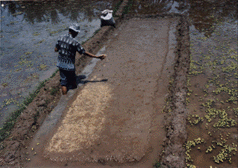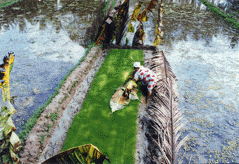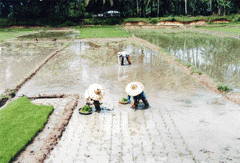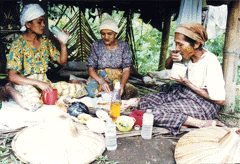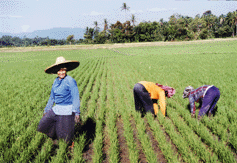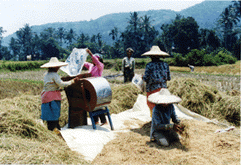Life Among the Minangkabau of Indonesia
Peggy Reeves Sanday
The Rice Cycle
Rice is the staple food for the Minangkabau, as it is throughout Southeast Asia. The Minangkabau say that if they don’t eat rice several times a day, they feel weak, their stomachs seem empty and their souls vacant. The Minangkabau can subsist mainly on rice with nothing else but a few peppers, fish, or small eels caught in newly irrigated rice fields.
Minangkabau rice has many names. Germinated rice seed is calledboniah. A field of unhulled and unhusked rice is called padi. Hulled and husked it is called beras. Cooked rice is called nasi. There are many other names for rice, depending on its color (white, yellow, or black), how it is prepared, and what it is used for. I have eaten rice boiled, baked, fried, and popped; with spices for dinner, fermented for breakfast; as a porridge for diarrhea and as a sticky substance wrapped in leaves and mixed with coconut milk or made into little cakes for a sweet treat. It would be impossible to count all the names and the ways one can eat rice. I never ceased to wonder at the new rice concoctionis that might be put in front of me at a meal or at a ceremony.
The photographs here show how rice is grown in Eggi’s village. The care with which the Minangkabau take in protecting the delicate seedlings from germination to final harvesting reminds me of the importance they attach to the idea that from weakness comes strength. They express this in one of their well-known proverbs, which says, “the unfurling, blooming, expansion of nature is our teacher.”
Pak Eddi, Eggi’s father, is sowing germinated rice seeds in the rice nursery. Once sprouted, they will be planted in the larger, irrigated field (to the right of the nursery).
2. Sprouting
About 10 days later Wik, Eggi’s mother, removes the banana leaves that had been placed over the seeds, which have now sprouted into seedlings. After a few days more, the seedlings will be planted in the irrigated rice field in neatly arranged rows.
3. Planting
Two women helpers plant the seedlings in neat rows, following a string they have tied to make the rows evenly spaced and parallel. Pak Eddi is in the background pulling weeds from the irrigated field.
4. Praying
At noon the women stop to pray and eat. First they wash their feet, hands, and face so they will be clean for prayer. Women are often seen praying in the fields in open shelters where they can retreat from the rain.
5. Eating
After praying, the next step is eating. The only food people will eat when working in the fields is rice, because they believe it makes them strong and energetic.
6. Weeding
After a few weeks when the plants have taken root and the water has been drained from the field, the women must weed. Although the work of weeding and planting is back-breaking, it’s also a time to be together and gossip.
7. Harvesting
A group of women is separating the rice from the stalks with a hand-operated machine. They are working with a group of men who have cut the stalks for them. The men are nearby watching the women until more stalks are needed.
8. Hulling
Once the rice is separated from the stalks it is taken to be hulled. Traditionally, this was done at home by hand. Now most people use a rice-hulling machine.
